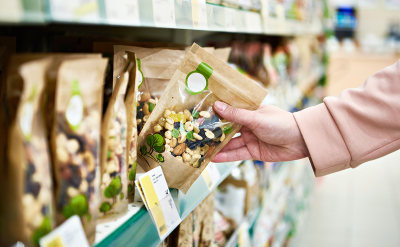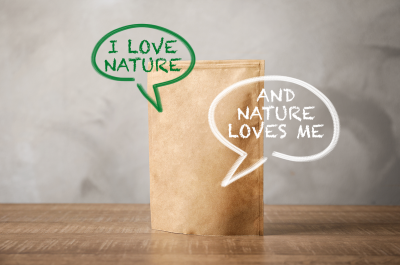Flexible Packaging: the top 4 trends to expect in 2020
Packaging plays an important role in the global economy, offering new opportunities for suppliers, packaging manufacturers and brands. Among the various packaging solutions available to choose from, flexible packaging is by far the most economical for preserving and packaging food, beverages, cosmetics and other such consumer products which require a long-term shelf life.
Flexible packaging is not only “flexible” in terms of pouching material but also because it offers the greatest versatility of choice to manufacturers. With pouching, customizing the look and feel of the package has unlimited potential, with innovative branding possibilities and multiple options for sizes, shapes, and open-and-close features such as zips and spouts.
As the flexible packaging market continues to expand, we reveal the four greatest trends that will drive the sector in the years to come.
REDUCTION OF MATERIALS AND COSTS
Compared to other forms of packaging, flexible pouching uses significantly fewer resources and energy in the production process. Flexible packaging additionally leads to a reduction of manufacturing costs in terms of the amount of materials used in the production process, resulting in higher performance than rigid packaging solutions such as glass or cardboard containers.
Lower transport costs are also a major feature of flexible packaging and are beneficial for all the players involved, from the packaging converter and packers/fillers, through to the retailer and end consumer. While flexible pouches are less bulky than rigid bottles or boxes, therefore taking up less space, what is even more advantageous is that pouches can be created from roll materials directly at the filling location, therefore eliminating the need to transport already-constructed containers that are empty.
Meanwhile, the continued pressure for a more environmentally friendly approach around the world continues to affect the flexible packaging sector considerably. This has led to the strategy of “downgauging,” meaning to use the thinner amount of film material to create the pouch. Aside from the ecological concerns, the high polymer prices of traditional materials (such as PET films) are likely to lead consumers to demand even finer film material.
INTRODUCING HIGH-PERFORMANCE MATERIALS
In addition to the trend of using thinner materials, in 2020 we are also seeing a growing usage of high-performance films. These superior film structures are usually less penetrable and therefore promote a longer shelf life. High-performance films also benefit the consumer’s enjoyment of the product that is being packaged, particularly enhancing the flavors of food and beverages.

Many premium products are being packaged in flexible pouches, including food which is sold in “modified atmosphere packaging” (MAP), particularly baked goods such as specialty bread and bakery products, half-baked bread, rolls and fresh cakes. This solution is beneficial for the consumer as well as the retailer since the MAP-packaged bread has a much longer shelf life.
It is unsurprising that flexible packaging is becoming a more popular packaging solution when one considers the advancements in technology. Improved barrier properties of clear plastic films, for instance, offer the customer to inspect the product visually before purchasing and opening, thus improving the trust and relationship with the brand from the get-go.
Meanwhile, the brand owner also benefits from being able to customize the level of the barriers between different pouches. In contrast with glass and metal packaging, in which very high barriers are imposed even when they are not needed — for instance, packaging refrigerated milk in a glass container is not mandatory to extend shelf life, since the oxidization process is incredibly slow and thus no barrier package is required in this case.
On the other end of the spectrum, products like wine which are quickly damaged when exposed to oxygen even when refrigerated, would need to be bottled and corked in glass. But flexible packaging is actually a transferable solution for both extreme examples of milk or wine, since in flexible pouches moisture levels and oxygen remain the same, in clear and opaque formats alike.
A CONSUMER-FOCUSED APPROACH
Because modern lifestyles are fast-paced and hectic, many consumers only have time for convenient meals, since they lack the time to cook. As a result of such socioeconomic trends, we can expect a continually higher demand for ready meals that are laminated in flexible packaging formats.

Refrigerated foods have also been on the rise over the past ten years, led primarily by the growing amounts of supermarkets, especially in developing countries. There is also a greater demand for “convenience food” that is pre-cooked or pre-sliced, which has equally led to the demand for MAP packaging.
In 2020, it is additionally more and more common to purchase edible goods in flexible packages rather than unpackaged options. This echoes the consumer need for quick and convenient solutions while also underlining the growing takeover of large supermarkets where both fresh and precooked food requires a much more extended life on the shelf.
BIO-BASED INNOVATIONS
Finally, the fourth big trend we are witnessing in 2020 is what is known as “bio-based plastic packaging” as an alternative to PET and petroleum-based PE. The notoriety of bio-based plastic films is maintained with polylactic acid (PLA), polyhydroxyalkanoates (PHA) and poly-trimethylene terephthalate (PTMT), and thermoplastic starch (TPS) films.
Some PE is grown from sugar cane raw materials in countries from Brazil to Japan and beyond. We also see a rise in vacuum-deposited barrier films produced from sugar cane mixed with different types of ethanol and petroleum-based elements, which allow the manufacturer to reduce their carbon footprint by a significant percentage compared to traditional barrier PET films.

In the US, we also see that some flexible packaging converters are innovating potato bags and partly manufacturing them out of potato starch resin mixed with a low-density polyethylene mixture. The result is that the film is much stronger and environmentally friendlier than the traditional solution.
FLEXIBILITY IS THE FUTURE
As we go further into the year 2020, Volpak’s prime concern is to stay focused on what is happening across the market at large and to keep up with industry trends. Thanks to this researched knowledge, the packaging manufacturers, brands and retailers working with Volpak can also be better equipped for future shifts in consumer habits and technological advancements.
Email us at Volpak to find out how we can help you maintain flexible packaging solutions that are in line with industry trends across the board.
